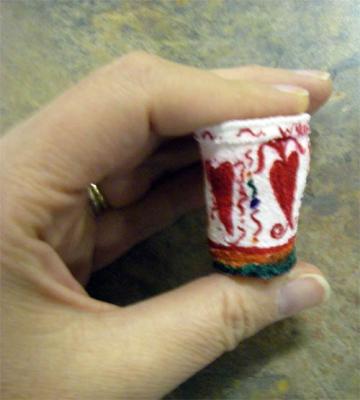I stuffed the cups with some sturdy brown paper towels to keep them separate and then placed them in a mesh laundry bag.
 Claire's Cup (Before)
Claire's Cup (Before)
Here is Claire’s cup before we sent it down.
The Marine Scientist Technicans (MSTs) connected them to the CDT sampler that was dropped below 3300 meters!
 How Deep?
How Deep?
I took this picture of the screen as the CTD was reeled up from the bottom.
How much pressure was down there? Scott Hiller, from Scripps Oceanographic Institution, plugged some numbers into an equation and told me that there was some 5100 psi (pounds per square inch) acting on those little white cups. The temperature was just above freezing.
 Strapped Cups
Strapped Cups
 Up from Deep
Up from Deep
The cups were strapped to the CTD. CTD stands for Conductivity, Temperature and Depth. It tells the scientists how salty, warm, and deep the Bering Sea is.
Two hours after dropping them down to the bottom of the Bering Sea, they emerged strapped and dripping.
And MUCH smaller.
Oh how CUTE!
 Shrinky
Shrinky
It will be a lot easier mailing these to the St. Paul students. My have they shrunk!
So what did we learn from this?
 Claire's Cup (After)
Claire's Cup (After)
Here is Claire’s cup after it was sent down to the bottom of the Bering Sea.
Well, there are lots more questions that arise. How far do the cups have to drop in order for them to compress? What is the tipping depth, the depth that they begin to compress? Does the length of time that they are submerged make a difference in how they compress? Where does the gas that is in the cup go?
Ah, science, sweet science, raising more questions than answering once again.

